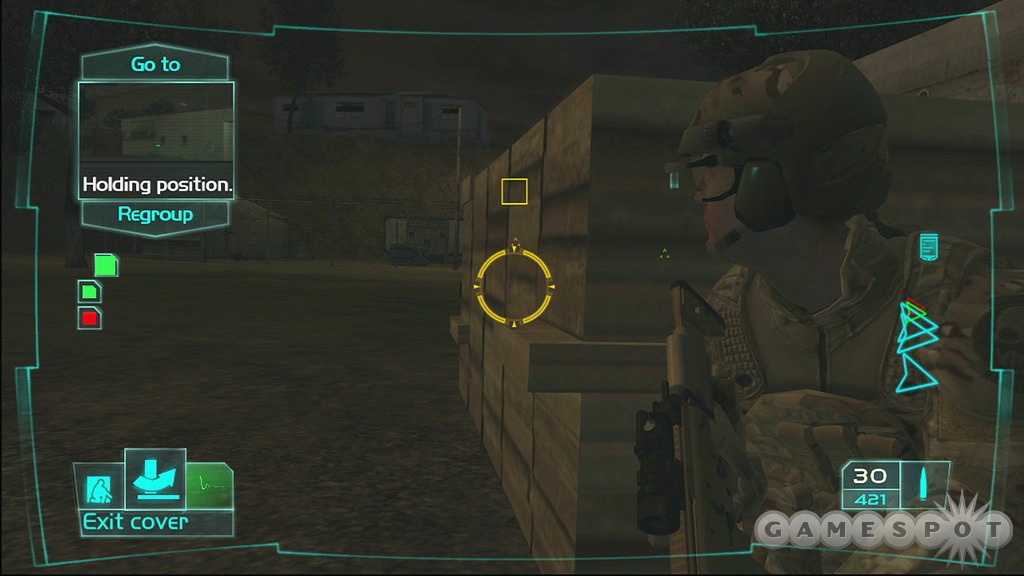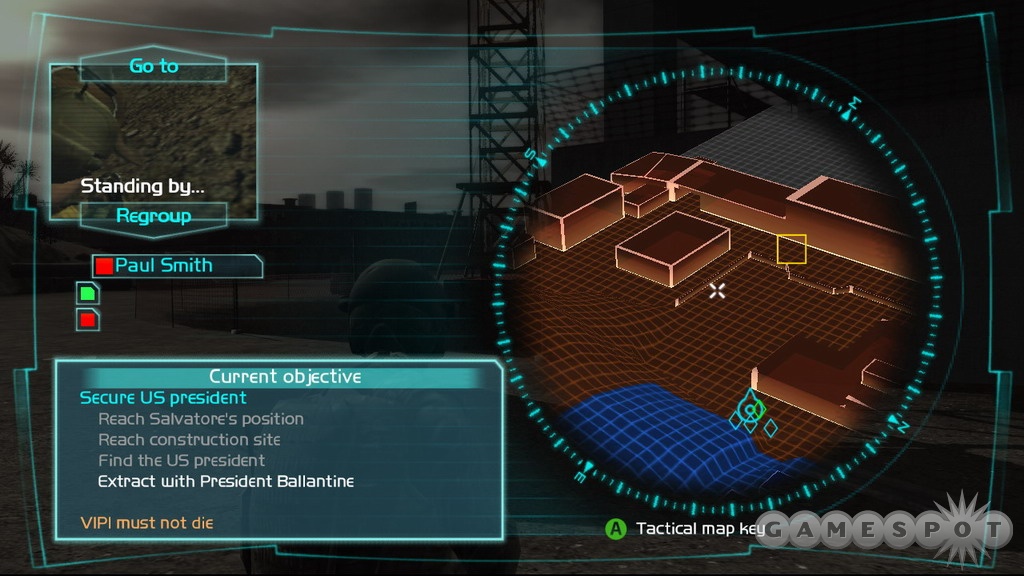When Ghost Recon Advanced Warfighter was first announced for the Xbox 360, it looked like a pretty ambitious project. Ubisoft was asking a lot out of the engine to have the game set entirely within a sprawling metropolis, complete with advanced lighting and particle effects, as well as lots of picture-in-picture video screens on the heads-up display. The early video and screenshots looked fabulous, so it was disappointing when the game didn't quite make the release of the system late last year. The wait was definitely worth it, though, as Advanced Warfighter isn't just the best-looking game on the Xbox 360, but also, arguably, the best game in the series.

You take the role of Scott Mitchell, a captain in the elite Ghosts--the light-infantry unit whose members are renowned for their skill and heroism in the face of long odds. You find yourself in Mexico City as part of the security entourage tasked with guarding a summit between the leaders of Mexico, Canada, and the US. Disaster strikes when Mexican rebels attack the summit, killing the Canadian prime minister and causing both the Mexican and US presidents to go missing. Over the course of the campaign, you'll explore the massive city--fighting rebel infantry, armored vehicles, and helicopters from within the dense, high-rise areas in the center to the dilapidated shanty towns on the outskirts. You'll do this solo and with the help of three teammates--who you can issue simple commands to--and supporting vehicles. Major landmarks, such as Chapultepec and the spire at Angel Plaza, are represented fairly accurately in the game's depiction of Mexico City.
The first thing you'll notice about the game is how breathtakingly massive and believable the city looks. You take several helicopter rides throughout the campaign, and the city is literally sprawled out all the way to the horizon with buildings and streets. Fires and smoke curl up into the sky from patches of fighting or factories. As you land, you find yourself engulfed by the metropolis and plying your way through the maze of buildings, streets, and alleys. The graphic detail extends not only to the character models, which are some of the best we've seen in a modern shooter, but also to the unique lighting and shadows. The sunlight is so bright and intense that it's almost oppressive at times, with the way the glare affects your vision, particularly when you're squinting through a scope. Some people may find this annoying, as the high-contrast lighting makes certain areas very hard to see. But, presumably, this overbearing light is pretty realistic of how daylight can be in a near-equatorial area.
Our only major complaint about the graphics is that for a city that looks so believable, it's as empty as a ghost town. Apparently, all 9 million residents of Mexico City either vanished or are hiding indoors with all the unrest going on. Still, it's a little eerie to see no cars moving around the streets and highways or people trying to go about their daily business. To be fair, though, it's only the stark realism of the environment that gets you to notice a flaw like this in the first place. The good news for those playing on standard-definition televisions is that the graphic quality of the game is plainly obvious no matter what type of television you use. HDTVs make it all the better of course, but even using just an S-Video connection, it's clear that a game that looks this good couldn't be done on a regular Xbox or PlayStation 2.

The size of the city affects the gameplay, in that at any given moment, you operate within several city blocks. There are often different ways you can take to get from point A to point B, and you're encouraged to explore around to find the best path. If, for example, you find a road block as you make your way down a street, it's usually possible to go around and try to flank those defenses from a different angle. Other missions let you climb up on something and take advantage of elevation for an assault instead of running headlong into entrenched defenses. The maps are not always so open-ended, though, and you can and will run into arbitrary borders if you try to. But for the most part, Advanced Warfighter does a nice job at keeping you from feeling hemmed in, and there's generally a good amount of freedom to roam. The game also does a good job at keeping up the tension by throwing enemies at you from different elevations. There's nothing quite as tense as turning a corner into a street that looks clear, only to narrowly miss getting sniped by a marksman on top of a roof that you didn't notice.
To help you get through these massive battlefields, the game lets you control not only a three-man support team, but also support vehicles, as well. Robotic UAV recon units, for example, can scout ahead and detect enemies that may be lurking. The enemies, as well as your objectives and teammates, are marked digitally on your HUD, so you can track them even when they're not in your line of sight. You'll do a lot of fighting in this game from extreme distances by shooting with scoped weapons, so the plain markings on your HUD often come in handy. At various times throughout the game, you'll command tanks or armored vehicles, as well as helicopter gunships. You can only command the tanks to move forward or backward, as if they're on rails, but they make for a good source of movable cover. Gunships are great for support fire, as you can command them to take out distant targets without getting into danger yourself. These support vehicles aren't invincible, though, so if you run your tank into a rocket-propelled-grenade ambush or send your choppers into machine-gun fire, they can go down.
Commands for your teammates are pretty basic. You can command them as a unit, and they'll respond to move, attack, or regroup commands. If you position them well, behind some low cover for instance, they're generally effective at shooting enemies, but they're not so smart about operating around corners. Too often when you command them to fire from around a corner, they'll step out and expose too much of themselves. They're also not so good about keeping themselves safe when they're following you behind a tank, but they do try to use the environment whenever possible to stay under cover. Commanding teammates may not be one of GRAW's highlights, but since you're probably doing most of the shooting anyway, it's not too big of a drawback, and they can be very effective in the right situations.

Advanced Warfighter affords you an impressive amount of control over your character. You can sidle up to any wall or flat surface and peek around the side by pushing up against it, which lets you peek around the corner while remaining safe. The game lets you fire around the corner or over a low wall with a minimally exposed profile, although this method of firing is less accurate. If you use a scope, you will expose more of your body to fire. You can kneel or go prone and even dive for cover if you try to go prone while running. There's a low-light mode, which you'll need to use for darker areas of the game. You do lose a lot of sharpness and resolution in this mode, so even in dark areas, you'll probably find yourself frequently switching in and out of this mode.
The fact that you can die in a single hail of fire, or just a few glancing shots, means a slow, tactical pace for GRAW. This is definitely a slower-paced fare than something like Call of Duty 2, since you can't fire accurately while on the move or at all when you're on a dead run. You'll definitely need to take advantage of corner-peeking and recon vehicles whenever possible to plan your movements and attacks. This aspect gives the game a bit more of a cerebral feel--but make no mistake, there's plenty of action in the game. There are no medikits. Occasionally, though, you'll find ammo stations on the battlefield that will heal you, and you'll also get healed whenever you rendezvous with a troop carrier to get new teammates or move to another location.
The game's campaign should last most players around 10 hours or so, counting restarts from death, but the campaign is fun enough that it's probably worth a replay on the hardest setting, which is devilishly difficult. GRAW offers plenty of value outside the single-player campaign as well, with 16-player online play over Xbox Live. There are standard deathmatch and capture the flag modes, which are fun and work pretty well with the 10 maps that are included. Some of the maps are symmetric, while others are not so much, and the environments offer a good variety no matter what sorts of levels you like--lots of cover for sneaking or more-open environments for faster gameplay. The most interesting aspect of GRAW's multiplayer repertoire is the included cooperative campaign. These are four specially designed missions for co-op play that can be played locally or online for up to 16 players. They're pretty fun, and the difficulty does scale depending on how many players are in the game.

The game's sound is an excellent complement to the fantastic graphics. The different guns have very unique sound effects, and they're all very sharp and impactful, which adds to the chaos of pitched battles. The best sound effect in the game, though, is the high-pitched whine of the Vulcan cannon as you spin it up and fire out the side door of a Blackhawk during the helicopter-combat portions. Just the sound of that gun as you hose down enemy infantry and vehicles with a hail of depleted uranium is enough to get any action-fan's blood pumping. Tank cannons and rocket explosions are literally deafening, as the game muffles the sound coming out of the speakers briefly if any explosions go off near you, thus simulating a deafening effect. There's some music that spools up during the gameplay, and the thumping beats suit the theme for the most part, but during some of the helicopter rides, licensed rock music comes up that sounds oddly out of place.
If you like shooters or action games, and you own an Xbox 360, Ghost Recon Advanced Warfighter is a must-own for your library. A solid and challenging campaign and a unique, online-co-op mode combine with an unmatched presentation in what is arguably the best game yet on the Xbox 360. Even those who don't necessarily like shooters may want to at least try the game out, as GRAW represents the best of what a tactical shooter can offer and can serve as a useful graphical benchmark to judge other games on the console by.